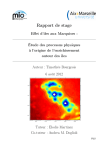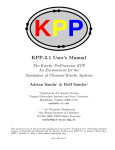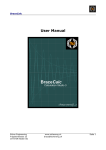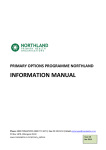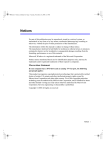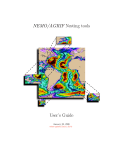Download AGRIF Adaptive Grid Refinement In Fortran User's Guide Version 1.3
Transcript
AGRIF Adaptive Grid Refinement In Fortran User’s Guide Version 1.3 27 novembre 2006 AGRIF is a package for the integration of adaptive mesh refinement (AMR) features within a multidimensional model written in Fortran and discretized on a structured grid. The package mainly consists in two parts. It first provides model-independent Fortran 90 procedures implementing the usual parts of an AMR process like time integration algorithm of the grid hierarchy, clustering algorithm, refinement algorithm, interpolation and update procedures, ... In a second part, the Fortran model-dependent code is created via a program which analyses a user’s written configuration file. The model independent part is compiled alone. The model dependent part is then compiled with the current model. Then they are linked. The first chapter deals with files which could be write in order to use AGRIF. The second one is based on the current model modification and also the way to use to compile the model and AGRIF. 1 Contents 1 Description of AGRIF 1.1 The configuration file . . . . . . . . . . . . . 1.1.1 Global parameters . . . . . . . . . . 1.2 agrif user file . . . . . . . . . . . . . . . . . 1.2.1 Agrif InitWorkspace subroutine . . . 1.2.2 Agrif InitValues subroutine . . . . . 1.2.3 Agrif detect subroutine . . . . . . . . 1.3 Agrif2Model file . . . . . . . . . . . . . . . . 1.4 Special Operations . . . . . . . . . . . . . . 1.4.1 Special values with interpolations . . 1.4.2 Getting the values on the parent grid 1.4.3 Using fixed grids in AGRIF . . . . . . . . . . . . . . . . . . . . . . . . . . . . . . . . . . . . . . . . . . . . . . . . . . . . . . . . . . . . . . . . . . . . . . . . . . . . . . . . . . . . . . . . . . . . . . . . . . . . . . . . 2 Using AGRIF in a multidimensional finite difference model 2.1 Necessary subroutines to run AGRIF . . . . . . . . . . . . . 2.1.1 Subroutines provided by AGRIF . . . . . . . . . . . . 2.1.2 Subroutines to be written by the user . . . . . . . . . 2.2 How to compile AGRIF (and your model with AGRIF) ? . . 2.2.1 Changes in the Makefile . . . . . . . . . . . . . . . . 2.2.2 Changes in the model . . . . . . . . . . . . . . . . . . 2.2.3 How to use the AGRIF package . . . . . . . . . . . . 2 3 3 3 5 6 7 11 12 12 12 13 14 17 17 17 17 18 18 19 20 Chapter 1 Description of AGRIF To use AGRIF, the user needs • to write a configuration file which contains model’s description. This file is read by the CONV during the code compilation, • A file where fixed grids are defined, • The file agrif user.F90 which contains users subroutines, • The file agrif2model.F90, which make the link between the model and the agrif library (this file should not be modify). All those steps are detailed below. 1.1 The configuration file The syntax used in the configuration file is presented next. All examples given here have no real signification; practicals examples are presented in the tutorial. 1.1.1 Global parameters Refinement dimension and domain size 1. Description The refinement dimension and the domain size are set with the keyword nD followed by one, two or three integer values corresponding to the number of cells in the directions of refinement. 3 Note that those integers must be global variables which must be defined in the parameter file and probably declared as parameters in the original model. 2. Syntax nD n1[,n2[,n3]]; / n ∈ 1,2,3, n1,n2,n3 : strings / 3. Examples 3D nx,ny,nz; / 3D refinement / 2D nx,ny; / 2D refinement (the model can be 2D or 3D) / Parameter file 1. Description The parameter file is the usual model’s file in which several parameters are declared, as the indexes delimiting the domain for example. Actually, the essential condition is that this file must contain the declaration of the cells number. If it is an included file, its name is given after the keyword paramfile. If these variables are defined in a module, we should use the keyword parammodule. 2. Syntax paramfile name; / name : string of characters / parammodule name; / name : string of characters / 3. Example paramfile parameter.h; parammodule modulename; Using fixed grids 1. Description Keyword FIXED GRIDS indicates that some fixed grids are used. 2. Syntax 4 USE FIXED GRIDS; 3. Example USE FIXED GRIDS; Using only fixed grids 1. Description Keyword ONLY FIXED GRIDS indicates that only some fixed grids are used, without moving grids. They are defined in the Agrif Fixedgrids.in 2. Syntax USE ONLY FIXED GRIDS; 3. Example USE ONLY FIXED GRIDS; not grid dependent variables 1. Description Keyword notgriddep indicates that a variable is not grid dependent. Consequently, these variable value will be the same on each grids and will not stored in the table tabvars. 2. Syntax notgriddep name; / name : string of characters / 3. Example notgriddep variable name; 1.2 agrif user file Severals subroutines should be defined in this file. • Agrif InitWorkspace • Agrif InitValues • Agrif detect Those subroutines are defined below. 5 1.2.1 Agrif InitWorkspace subroutine In this subroutine, the user should define all variables which are computed from the grid dimension on the fine grid. For example if ( .NOT. Agrif_Root() ) then nx1=nx+1 ny1=ny+1 endif If the amr has been defined in the configuration file, all AMR parameters should be defined in this subroutine : • Efficiency 1. Description The efficiency is relative to the clustering algorithm and represents the proportion of grid points included in the newly created points which were really detected. The default efficiency is set to 70%. The user can change this value the subroutine Agrif Set Efficiency. 2. Example Call Agrif Set Efficiency(0.8) • Regridding 1. Description The regridding operation is performed periodically, every N coarse grid time steps. This number N is set by the subroutine Agrif Set Regridding. 2. Example Call Agrif Set Regridding(10) • Space refinement factors 1. Description The space refinement factors for new grids created by adaptive mesh refinement are set by subroutines Agrif Set coeffref x, Agrif Set coeffref y and Agrif Set coeffref z. 2. Syntax Call Agrif Set coeffref x(3) / n : integer / • Time refinement factors 6 Call Agrif Set coeff 1. Description The time refinement factors for new grids created by adaptive mesh refinement are set by using subroutines Agrif Set coeffreft x, Agrif Set coeffreft y and Agrif Set coeffreft z. 2. Example Call Agrif Set coeffreft x(2) Call Agrif Set coeffreft y(2) Call Agrif Set coeffreft z(2) Minimum width 1. Description The minimum width is the minimum size of the grids (in number of cells) created during the regridding operation. This number is set with the subroutine Agrif Set minwidth. 2. Example Call Agrif Set minwidth(5) • Maximum number of refinements 1. Description The maximum number of refinement is defined for all space direction by using subroutines Agrif Set rafmax. 2. Example Call Agrif Set rafmax(5) 1.2.2 Agrif InitValues subroutine This subroutine is called once on each fine grid. Firstly, we should call the subroutine which allows to initialize the current grid (the same subroutine which allows to initialized the coarse grid). Call init() If some specific treatments of one variable are required (initialization, boundary interpolation, restoration), this one has to be ”fully declared”. This means that the type of the variable, the indices of the first point in the domain, and the type of its dimensions must be declared. We should call following subroutines : 7 • Position of the variable 1. Description We should specify the position of the variable on the grid, by calling the subroutine Agrif Set type. That allows the use of staggered grids. For each space direction, we use 1 for the boarder of a cell (figure 1.1) and 2 for the center of the cell (figure 1.2). Remember that a staggered grid variable can be used in a space direction only if this direction is refined. . . Figure 1.1: Positions of a grid variable on a no staggered variable . . Figure 1.2: Positions of a grid variable on a staggered variable Next, it is necessary to declare the index of the first point of the variable which is inside the computational domain. At last, the user must indicate the type of each dimension by using the subroutine Agrif Set raf : x,y or z for a space dimension, 0 for a no space dimension. 2. Syntax Call Agrif Set type(u,(/p1,p2/),(/i1,i2/)) / p1,p2,p3,i1,i2,i3 : intege Call Agrif Set raf(u,(/’n1’,’n2’/)) / n1,n2,n3 : x,y,z or N / (p1,p2,p3 indicate the position of the grid variable and i1,i2,i3 the index of the first point in the domain). 3. Example For a 2D domain, four different ways for positionning a variable on a cell are possible. Call Call Call Call Call Agrif Agrif Agrif Agrif Agrif Set Set Set Set Set type(vr,(/1,1/),(/1,1/)) type(u,(/2,1/),(/1,1/)) type(v,(/1,2/),(/1,1/)) type(h,(/2,2/),(/1,1/)) Raf(u,(/’y’,’N’/)) Figure (1.3) shows these positions on a cell. 8 h(1,1) u(1,1) vr(1,1) v(1,1) Figure 1.3: First points in the domain • Interpolation 1. Description AGRIF can interpolate variables of the current grid which are declared with the subroutine Agrif Set interp in this subroutine. 2. Syntax Call Agrif Set interp(name,interp=method) / method of interpolation 3. Example Call Agrif Set interp(u,interp=Agrif linear) • Boundary interpolation 1. Description AGRIF can, in a similar way, provide subroutines for the interpolation of boundary values if necessary. The name of the concerned variables must be given after with the subroutine Agrif Set bc, followed by a description such as (ideb:ifin) or (iind), where these last indices indicate where to interpolate. For variables which have been also declared by with the subroutine Agrif Set interp, the default interpolation type used in the 9 boundary corrections is the same that the one used in the Agrif Set interp called. If the variable is not declared by using the subroutine Agrif Set interp or if another kind of interpolation for the boundary is desired, the subroutine Agrif Set bcinterp should be called. 2. Syntax Call Agrif Set bc(var,(/ideb:ifin/)) / ideb,ifin : integers / Call Agrif Set bcinterp(var,method) / method = linear, lagrange, spli Figure (1.4) represents (in 2D and for the different types of variables) the positions which will be corrected if you specify (-1). Figure (1.5) represents (in 2D and for the different types of variables) the positions which will be corrected if you specify (0). Figure (1.6) represents (in 2D and for the different types of variables) the positions which will be corrected if you specify (1). . typex = 1 typey = 1 typex = 2 typey = 2 typex = 2 typey = 1 typex = 1 typey = 2 . Figure 1.4: Grid corrections, BC :: var : (-1) • Update of the grid variables The AGRIF package is able to update grid variables from their parent grid. 1. Description AGRIF can update the variables of the parent grid of the current grid which are declared with the subroutine Agrif Set UpdateType . 2. Syntax Call Agrif Set UpdateType(var,update=method) / method of interpolati 3. Example 10 . typex = 1 typey = 1 typex = 2 typey = 2 typex = 2 typey = 1 typex = 1 typey = 2 Figure 1.5: Grid corrections, BC :: var : (0) . Call Agrif Set UpdateType(u,update=Agrif Update Average) • Restoration (adaptive mesh refinement only) 1. Description During a step of mesh refinement and for each variable, the user can specify that its value must be restored (if possible) for the initialization of the newly created grids. This is accomplished by calling the subroutine Agrif set restore. 2. Syntax Call Agrif set restore(var); 3. Example Call Agrif set restore(u) 1.2.3 Call Agrif set restore(v) Agrif detect subroutine This subroutine is used in order to detect points where raffinement is required. This subroutine should be write when an adaptative mesh raffinement is necessary. 11 . typex = 1 typey = 1 typex = 2 typey = 2 Figure 1.6: Grid corrections, BC :: var : (1) typex = 2 typey = 1 typex = 1 typey = 2 . 1.3 Agrif2Model file The CONV program allows to create a new fortran code and also files (in AGRIF INC directory) which are used to complete the agrif2model file. So, in the Makefile we should compile the agrif2model file at the end of the compilation just after the compilation of the last model file. 1.4 1.4.1 Special Operations Special values with interpolations Before a call to the Agrif Interp VarName or Agrif Bc VarName subroutines, you can specify the use of some special values for the arrays of the parent and fine grids concerned by these interpolations. The necessary keywords are Agrif UseSpecialValue and Agrif SpecialValue for the parent grids, Agrif UseSpecialValueFineGrid and Agrif SpecialValueFineGri for the fine grids. Agrif UseSpecialValue and Agrif UseSpecialValueFineGrid are two logicals whereas Agrif SpecialValue and Agrif SpecialValueFineGrid are two reals. Special values on the parent grids If you want to use a special value for the parent grid (for example 98.8 here), you must add the following lines before any call to an Agrif Interp VarName 12 or Agrif Bc VarName subroutine : AGRIF UseSpecialValue = .TRUE. AGRIF SpecialValue = 98.8 Then, if a value on the part of the parent grid used for the space interpolation of the fine grid is equal to 98.8, this value will be replaced, if possible, by the nearest value of the parent grid different of 98.8. Special values on the fine grids If you want to use a special value for the fine grid (for example 50.0 here), you must add the following lines before any call to an Agrif Interp VarName or Agrif Bc VarName subroutine : AGRIF UseSpecialValueFineGrid = .TRUE. AGRIF SpecialValueFineGrid = 50.0 Then, if a value on the fine grid is equal to 50.0, this value won’t be replaced during the interpolation. 1.4.2 Getting the values on the parent grid Sometimes, the user need to know the values on the parent grid of the current grid (to write its own routines of interpolation and update for example). AGRIF offers this possibility. How to get the values on the parent grid ? In order to get the value on the parent grid we should call the function Agrif Parent. Example : Agrif Parent(u) • For a scalar variable : Real :: dtp dtp = Agrif Parent(dt) • For a multidimensionnal variable : Real, Dimension(:,:), pointer :: parent u 13 parent u ⇒ Agrif Parent(u) parent u(i,j) = 3. What is the correspondance between points on fine and parent grids ? For a no staggered variable, a point on a parent grid always corresponds with a point on the child grid, whatever the space refinement factors are; the same holds for a staggered variable with an odd space refinement factor. Concerning a staggered variable with an even space refinement factor, this correspondence does not exist as it is shown on the figure (1.7). . Point of the coarse grid Points of the fine grid Coarse cell Fine cells . Figure 1.7: Staggered variable with a space refinement factor equal to 2 The correspondances between the fine and coarsed grids points are given by the following algorithm : Do i = idebf ,...,coef f raf i−ideb f V arG (idebg + ( coef f raf )) = V arf (i) End Do where the values of idebf and idebg depend on the type of the variable (staggered or no staggered) : idebf idebg No staggered variable ptx ix + ptx − 1 coef f raf −1 Staggered variable ptx + ix + ptx − 1 2 where ptx is the index of the first point inside the domain and ix the minimum position of the current grid on its parent grid. 1.4.3 Using fixed grids in AGRIF One of the features of the AGRIF package is its ability to deal with the use of fixed fine grids in the domain. 14 First, the user must insert the keyword USE FIXED GRIDS in the configuration file; he must add the keyword USE ONLY FIXED GRIDS if he want to use only fixed grids and no moving grids. Next, he must declared the fine grids in a file called AGRIF FixedGrids.in which has to be in the current directory where the code runs. For each fine grid and each space direction, a line indicates its position on its parent grid and its space and time refinement factors. Syntax • 1D imin imax spacerefx timerefx • 2D imin imax jmin jmax spacerefx spacerefy timerefx timerefy • 3D imin imax jmin jmax kmin kmax spacerefx spacerefy spcerefz timerefx timerefy timerefz Imin,imax,jmin,jmax,kmin,kmax are six integers indicating the minimum and maximum positions of the fixed grids; in this definition, the positions of the corner points refer to the positions of the parent grid corners, starting with the value 1 in each space direction. When the user writes these positions, he has to take care that each fine grid is contained in a parent fixed grid. Spacerefx, spacerefy, spcerefz, timerefx, timerefy and timerefz are six integers indicating space and time refinement factors in the x,y and z directions. If one of these factors are equal to 1, it means there is no refinement in the concerned space direction. Example Figure (1.8) gives an example in dimension 2. The root coarse grid (G0) has two child grids G1 and G2 , and G1 has one child grid G3 . Space and 15 time refinement factors are equal to 2 in both space directions. . . Figure 1.8: Fixed grids example For this example, the AGRIF FixedGrids.in file must contain the following lines: 2 2 4 1 4 0 0 7 7 4 1 7 3 2 2 2 2 2 2 10 2 6 2 2 2 (G0 has 2 child grids : G1 and G2) 2 (positions and refinement factors for 2 (positions and refinement factors for (G1 has 1 child grid : G3) 2 (positions and refinement factors for (G3 has no child grid) (G2 has no child grid) Fixed grids with adaptive mesh refinement When the keyword USE FIXED GRIDS is in the configuration file without the keyword USE ONLY FIXED GRIDS, you have at the same time in the grid hierarchy fixed grids and moving grids. 16 Chapter 2 Using AGRIF in a multidimensional finite difference model 2.1 2.1.1 Necessary subroutines to run AGRIF Subroutines provided by AGRIF Agrif Init Grids This routine creates the characteristics of the root coaser grid ( number of cells, ...). It is called in the main file after the initialization of the number of cells on the coarser grid. Agrif Step This routine calls and replaces the user’s time integration procedure (named Step) the user has to write. It integrates the model forward on all grids and performs a regridding at regular interval (in case of adaptive refinement). 2.1.2 Subroutines to be written by the user Agrif Initvalues This routine allows to initialize the fine grid variables. It is called in the procedure of refinement. Agrif Initworkspace This routine contains, for each space direction, the links between variables declared in the parameter file and representing the size of the domain and the number of cells. For example, if nx is the number of cells and nxp1 the number of grid points, then the sentence nxp1 = nx + 1 must be written in this routine. 17 Agrif Initworkspace is called after each change of grid to recalculate the corresponding values. Agrif Detect This routine is necessary if AGRIF is used in adaptative mode. It allows to write the adaptative mesh raffinement criterion. 2.2 How to compile AGRIF (and your model with AGRIF) ? 2.2.1 Changes in the Makefile The Makefile should be modify in order to use AGRIF library Create a AGRIF key In order to determine if AGRIF is used or not in the current model, we should created an AGRIF key. Let’s say key agrif. CCP_FGLAGS = -Dkey_agrif This key allows to : • Compile or remove the AGRIF source code during the preprocessing. For example in the source code : #if defined key_agrif code for AGRIF #else code without agrif #endif • Determine in the Makefile if AGRIF should be used ifneq (,$(findstring key_agrif,$(CPPFLAGS))) Makefile with AGRIF else Makefile without AGRIF endif 18 Compile the AGRIF library The AGRIF directory should be place in code tree. In the makefile we should begin with AGRIF library compilation in order to create a libagrif.a file which could be used later. To compile it, the user should use the Makefile presents in AGRIF. Use CONV Add the compilation of the file Agrif User.F90 at the end of the object list. Now we should create a source code compatible with AGRIF using the CONV program. Consequently, for each file compilation : • we should move this file in an other directory in order to work on the file without removing the original one. • apply the conv on this file which allows to create a new fortran file. • compile this new file For example, let’s use a directory call NEW FILES. Foe each file compilation we should have : $(CPP) $(CPPFLAGS) $(*).F90 > NEW_FILES/$(*).F90 (cd NEW_FILES; ./conv agrif.in -comdirin ./ -comdirout AGRIF_MODELFILES -r $(CPP) $(CPPFLAGS) -INEW_FILE/AGRIF_INC NEW_FILE/AGRIF_MODELFILES/$(*).F90 $(F_C) NEW_FILE/$(*).F90 Compile Agrif2Model file Just before the final link, the user should complete the Agrif2Model file with the help of files presents in AGRIF INC directory by preprocessing. 2.2.2 Changes in the model This section describes the few changes the user has to make in his original code to be able to run the AGRIF package. 19 Modifying the parameter file This file must contain the domain sizes and variables that depend on those sizes. For example if you had in your original common, a declaration like integer nx,ny,nz parameter (nx=100,ny=100,nz=30) integer,parameter :: nxp1=nx+1,nyp1=ny+1,nzp1=nz+1 change it into integer nx=100,ny=100,nz=30 integer nxp1=nx+1,nyp1=ny+1,nzp1=nz+1 Modifying the main program For running AGRIF, you should replace the call to your original time integration procedure by ’call AGRIF STEP’ (see section 2.1.1). You should also add a call to the Agrif Init Grids (see section 2.1.1) subroutine. This call must be done after the initialization of the number of cells. Writing some procedures You should write the Agrif Initvalues and Agrif Initworkspace procedures (see section 2.1.2). 2.2.3 How to use the AGRIF package After making the changes described in the previous section, the user has to write the configuration file (see section 1.1) and to compile the library. Writing the AGRIF FixedGrids.in file This file (described in section 1.4.3) is necessary if you want to use some fixed grids. It must be positioned in the main directory where the model runs. Writing the configuration file Here, we try to present how the user could process to get an idea of what he should put in the configuration file : 1. count the numbers of cells in the X,Y and Z directions 20 2. get the parameter file name 21























